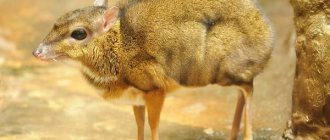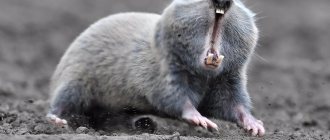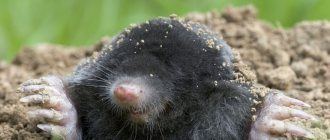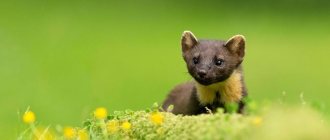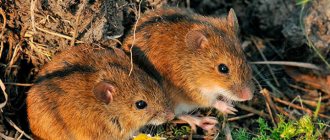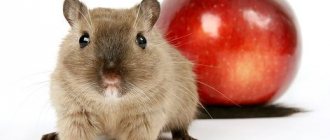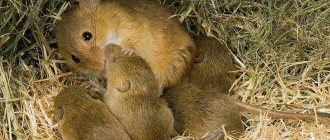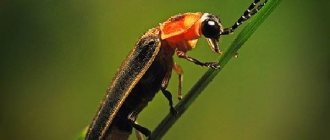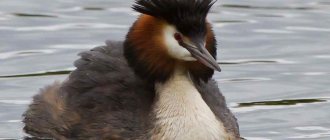| Etruscan shrew [1] | |
| Save Status | |
| Least Concern (IUCN 3.1) [2] | |
| Scientific classification | |
| Kingdom: | Animalia |
| Type: | Chordata |
| Class: | Mammals |
| Order: | Eulipotyphla |
| Family: | Soricidae |
| Genus: | Suncus |
| Variety: | S. etruscus |
| Binomial name | |
| Suncus etruscus (Savi, 1822) | |
| Range of Etruscan shrews (blue - local, black - probably extant origin unknown) | |
Pygmy shrew
(
Etruscan shrew
), also known as
the Etruscan pygmy shrew
or
white-toothed pygmy shrew
, is the smallest known extant mammal by mass, weighing only about 1.8 g (0.063 oz) on average. [3][4][5][6][7] (The bumblebee bat is considered the smallest mammal based on skull size and body length.[3][8])
The Etruscan shrew has a body length of about 4 cm (1.6 in) excluding the tail. It is characterized by very fast movements and a fast metabolism, consuming 1.5–2 times its body weight per day. It feeds on a variety of small vertebrates and invertebrates, mainly insects, and can prey on individuals the same size as itself. These shrews prefer warm, humid climates and are widely distributed in a band between 10° and 30° north latitude, extending from Europe and North Africa to Malaysia. They are also found on the Maltese islands, located in the middle of the Mediterranean Sea. [2] [5] Although they are widespread and generally not endangered, they tend to be rare and endangered in some countries.
Description[edit]
The Etruscan shrew has a slender (not truncated) body, measuring between 3 and 5.2 cm (1.2 and 2.0 in) long, excluding the tail, which adds another 2.4-3.2 cm (0.94- 1.26 inches). [9] Body weight ranges from 1.3 g (0.046 oz) [8] to 2.5 g (0.088 oz) [4] [9] and is usually around 1.8 g (0.063 oz). [3] By comparison, the larger white-toothed shrew can be twice as long and weigh four to five times as much. [9] The head is relatively large, with a long, movable proboscis, and the hind limbs are relatively small. [10] The ears are relatively large and prominent. [9] The Etruscan shrew has a very fast heartbeat, up to 1511 beats per minute (25 beats per second), and a relatively large mass of cardiac muscle, 1.2% of body weight. [3] The color of the coat on the back and sides is pale brown, but on the belly it is light gray. In winter, the fur becomes thicker and thicker. [9] The shrew usually has 30 teeth, but the 4th upper pontic is very small (vestigial) and is missing in some individuals. [6] A thick array of short whiskers grows near the mouth, which the shrew actively uses to search for prey, especially at night. [7] There is no dimorphism in body features between males and females. [10]
Interesting Facts
One interesting fact is known about the shrew. It is due to the fact that its smallest species live precisely where the harshest living conditions occur - the tundra, highlands, Siberia - and, logically, should strive for more favorable territories. Moreover, the size of the animal can be smaller the further north it lives - which contradicts Bergman’s rule, according to which the size of individuals should change upward due to cold. Many shrews in the northern regions are able to reduce the size of their internal organs during the winter in order to reduce heat loss.
Activities [edit]
Etruscan shrews are solitary except during mating periods. Their lifespan is usually about two years, but with a large margin of error. [9] [11] They defend their territories by making chirps and signs of aggression. [12] They tend to groom themselves constantly when not eating, and are always moving when awake and not hiding. Covering periods are short and usually last less than half an hour. When shrews move, clicking sounds are heard, which stop when they rest. [10] Shrews are more active at night when they make long trips; During the day they stay near the nest or in a shelter. [6] At dawn they reach their maximum level of activity.[2]
Due to its small size and resulting high surface area to volume ratio, the Etruscan shrew is constantly at risk of hypothermia and would quickly freeze if not for its extremely fast metabolism. Its skeletal muscles contract at a rate of about 13 contractions per second during breathing alone. During cold seasons and times of food shortage, shrews lower their body temperature to approximately 12 °C (54 °F) and enter a state of temporary hibernation to reduce energy consumption. The exit from this state is accompanied by trembling with a frequency of 58 muscle contractions per second. [3] This causes heating at a rate of up to 0.83 °C/min, one of the highest values recorded in mammals; the heart rate increases exponentially over time from 100 to 800–1200 beats/min, and the respiratory rate increases linearly from 50 to 600–800 beats/min. [4]
Etruscan shrews mate primarily from March to October, although they can become pregnant at any time of the year. Pairs usually form in the spring and can tolerate each other and their young in the nest for a while. The gestation period is 27–28 days, and they have a litter of 2–6 young. [2] [9] The cubs are born naked and blind, weighing only 0.2 g (0.0071 oz). Once their eyes open at 14 to 16 days of age, they mature quickly. The mother usually moves the cubs around 9 to 10 days old, and if disturbed, she moves them by leading them with her tail in a train-like fashion, with each cub biting the tail at the front. Young Etruscan shrews are weaned at 20 days of age. By three to four weeks of age, the young become independent and soon become sexually mature.[5] [9] [10]
Shrew behavior
Shrews are very energetic animals and are nocturnal. During the day they search for food only near shelters. They hunt on the ground, sometimes climbing out onto low-growing grasses and shrubs. They move very quickly, jump 10-15 cm. They do not hibernate, and in winter they continue to actively search for food. At this time they live in deep drifts.
Distribution[edit]
The Etruscan shrew inhabits a belt extending from 10° to 40° north latitude across Eurasia. [3] In Southern Europe, it has been found in Albania, Bosnia and Herzegovina, Bulgaria, Croatia, Cyprus, France, North Macedonia, Malta, Montenegro, Greece, Italy, Portugal, Slovenia, Spain and Turkey, with unconfirmed reports in Andorra, Gibraltar and Monaco; it was introduced by humans to some European islands such as the Canary Islands. [2]
The shrew is also found in North Africa (Algeria, Egypt, Libya, Morocco, Tunisia) and around the Arabian Peninsula (Bahrain, Israel, Jordan, Lebanon, Oman, Syria and Yemen, including Socotra). In Asia, it has been observed in Afghanistan, Azerbaijan, Bhutan, China (Gengma County only), Burma, Georgia, India, Iran, Iraq, Kazakhstan, Laos, Malaysia (Malaysian part of Borneo island), Nepal, Pakistan, Philippines, Sri Lanka , Tajikistan, Thailand, Turkey, Turkmenistan and Vietnam. There are unconfirmed reports of the Etruscan shrew in West and East Africa (Guinea, Nigeria, Ethiopia) and in Armenia, Brunei, Indonesia, Kuwait and Uzbekistan. [15]
Overall the species is widespread and not endangered, but its densities are generally lower than those of other shrews found in the area. [2] It is rare in some regions, especially in Azerbaijan, Georgia (listed in the Red Book), Jordan and Kazakhstan (Red Book). [5]
Habitat[edit]
The Etruscan shrew prefers warm, moist habitats covered with shrubs, which it uses to hide from predators. Areas where open terrain such as grasslands and scrub meet deciduous forests are typically inhabited. [9] It can be found at sea level, but is usually limited to the foothills and lower belts of mountain ranges, although it has been found at elevations up to 3,000 m (9,800 ft) above sea level. [9] It colonizes coastal thickets along the banks of lakes and rivers, as well as human-cultivated areas (abandoned orchards, orchards, vineyards, olive groves and field edges). However, the shrew avoids intensively cultivated areas, as well as dense forests and sand dunes. [2]It is poorly adapted to digging holes, so it makes its nests in various natural shelters, crevices and other people's uninhabited holes. [5] [6] They are often found in rocks, boulders, stone walls and ruins, quickly rushing between them. [9]
Natural enemies
The tiny little thing, foul-smelling and very evil, oddly enough, also has its enemies:
- small predators;
- predator birds;
- snakes and vipers;
- predatory fish;
- representatives of their own species;
- parasites.
It is interesting that when studying the common shrew, more than one and a half dozen species of various parasites and helminths were found in its representatives. One individual could contain more than 500 worms.
Usually the shrew is not bothered by people - although sometimes they can suffer in the event of mass persecution of rodents. Most often, people harm it indirectly - through changes in the habitat (development, deforestation, etc.).
Hunting and feeding[edit]
Due to its high surface area to body volume ratio, the Etruscan shrew has an extremely fast metabolism and must consume 1.5–2.0 times its weight in food per day. It feeds primarily on a variety of invertebrates, including insects, larvae and earthworms, as well as juvenile amphibians, lizards and rodents, and can hunt prey almost as large as itself. It prefers species with a soft and thin exoskeleton, so avoids ants when given a choice. Grasshoppers, if common, are often common prey. [9]It kills large prey with a bite to the head and immediately eats it, and carries small insects back to its nest. [5] [6] [7] It relies primarily on touch rather than sight when hunting, and may even stumble upon food at night. [10]
Ways to fight
For prevention, nets with small cells are installed around the perimeter of the site. The foundation is buried at least one and a half meters. You can regularly dig up the garden to a depth of 25 cm to destroy holes and labyrinths. Some also lay a fine metal mesh under the lawn.
If the shrews are already infested and you need to get rid of them, they use several types of methods.
Physical
This category includes all methods directly related to shrews:
- Catching with cats and dogs . Almost no domestic animal will eat the animal, but will chase it for the thrill of the hunt with great pleasure and may accidentally strangle it. Night hunts force mammals to change their location;
- use of traps and snares . Rat and mouse are quite suitable. Bugs, larvae, and earthworms serve as bait. There are traps that are placed in holes, such as the SuperCat Vole Trap. After capture, the animals are killed or released away from the site;
- flooding and poisoning of burrows . Water is poured into the tunnels and poisonous gas is released.
In addition, as for prevention, they arrange a global digging of the earth with the destruction of labyrinths.
All these options can deprive animals of their home and force them to leave. But there is absolutely no guarantee of no return.
Repellent
A humane way to force shrews to make space. However, a stubborn beast can fight until victory or return later when everything calms down.
Applicable:
- sound repellent . Ultrasonic devices with special sound frequencies and homemade “noise makers” are used. Ultrasound cannot be heard by pets or people. But rodents and shrews hear. Small elements are placed directly on the plots. Among the best are Antikrot, GRAD and Tornado 03B. The radius of operation is up to 20 m. Tin and glass jars with attached sticks act as homemade repellers. The jars are buried in the ground, the sticks are hung so that they knock on the walls when the wind blows;
- repelling by the smell of plants . Shrews do not tolerate strong aromas. In the garden it helps to make plots of mint, onions, marigolds, garlic, beans, wormwood and other plants with a persistent odor;
- scaring off with folk remedies . Savvy gardeners throw rags with kerosene and gasoline into the holes, “fertilize” the labyrinths with rotten fish, birch tar, moss and burnt rubber (they put a smoking piece in the hole).
Such methods should be repeated several times. Care must be taken with odorous products around pets. Among other things, a strong smell may not be the most pleasant for a person.
When using strong-smelling substances, you must use a mask or respirator.
Chemicals
Which method of dealing with shrews would you choose?
ChemicalRepellent
The most cruel and radical method of eliminating shrews. Experienced summer residents do not recommend resorting to it unless absolutely necessary. Exceptions are considered to be when the activity of an insectivore begins to actively interfere with the growth of crops.
A large number of standards can really slow down the growth of vegetables, grains and flowers. Root vegetables and berries often completely fall underground. The abundance of gnawed roots is also not conducive to obtaining a good harvest. If such a disaster occurs, chemicals are used.
Expert opinion
Mityuk Stefania Bogdanovna
When using chemicals, precautions must be taken. Processing should be carried out in the absence of children and animals. Protective clothing, mask and gloves will be required. In case of contact with eyes or skin, consult a doctor.
The drugs are aimed at poisoning and paralysis of the nervous and respiratory systems. Shrews simply become immobilized and die from oxygen starvation.
The list of leading chemicals includes the following items:
| Name | Peculiarities | Mode of application | approximate cost |
| Thick substance resembling dough. They are eaten by animals. Death occurs on days 4-6. | Placed in containers near habitats. 1 packet for every 20 m or less (depending on rodent population) | 100 rub. for 200 g | |
| Dollets. Red granules. The animals eat the product instead of food. Death occurs within 7 days. Mortality rate 100%. | Consumption 1 kg per 1 ha. They fall asleep in holes. | 950 rub. for 3 kg | |
| Causes painful death from internal bleeding. Valid in 4-8 days. The packaging indicates safety for humans, pets, livestock, bees and birds. | They fall asleep in holes. 1 package is distributed to a plot of up to 10 acres. Sufficient quantity for shrews and small mice. | 40 rub. per 100 g | |
| Solution. Complete death on days 4-14. Works for acute food poisoning. Can be used in greenhouses and indoors. | Mix with bait (bugs, worms, dead larvae). Place it near the holes. 1 part liquid to 49 parts food. | 750 rub. for 1 l | |
| Concentrated solution with low consumption. Lay out for every 15 m of space. Also effective against mice and rats. | Mix with bait. 20 g of concentrate per 1 kg of food. | 1500 rub. for 1 l |
After chemical treatment, dead shrews must be collected and burned.
Shrews are not the worst pests for a garden or area near a house. They do a lot of useful work instead of humans. If they are present, you can practically not worry about insect pests. At the same time, animals are capable of destroying lawns, damaging plant roots and preventing them from growing.
You should not get rid of a shrew without good reason. You especially shouldn’t resort to strong poisons right away. To begin with, it is recommended to try humane methods of disposal, try to drive away with sound or smell, destroy homes and labyrinths.
Repellers can be bought in stores or made independently from available materials. The method is not only as gentle as possible, but also costs less than chemicals.
To drive away or not to drive away? Each gardener will have to decide for himself.
Links[edit]
- ^ ab Hutterer, R. (2005). Wilson, DE; Reader, D. M. (ed.). Mammal Species of the World: A Taxonomic and Geographical Guide (3rd ed.). Johns Hopkins University Press. p. 258. ISBN 978-0-8018-8221-0. OCLC 62265494. direct link
- ^ B s d e g Aulagnier, S., HUTTERER, R., Jenkins, P., Bukhnikashvili, A., Kryštufek, B. & Kock, D. (2017). Suncus etruscus
. IUCN Red List of Threatened Species 2022. doi: 10.2305/IUCN.UK.2017-2.RLTS.T90389138A22288134.en - ^ B s d e e Jurgens, Klaus D. (2002). "Muscles of the Etruscan Shrew: Consequences of Small Size". Journal of Experimental Biology
.
205
(Pt 15): 2161–2166. PMID 12110649. - ^ abc Fons R.; Sender S.; Peters T.; Jurgens K.D. (1997). "Warming rates, heart and respiratory rates and their implications for oxygen transport during torpor arousal in the smallest mammal, the Etruscan shrew Suncus etruscus" (PDF). Journal of Experimental Biology
.
200
(Pt 10): 1451–1458. PMID 9192497. - ^ abcdefgh Suncus etruscus, Red Book of Kazakhstan.
- ^ abcdef "Dwarf shrew (Suncus etruscus)". ours-nature.ru
(in Russian). - ^ abc "Vibrissal touch of an Etruscan shrew". Scholarpedia.org
. Retrieved March 21, 2013. - ^ ab Bloch, Jonathan I.; Rose, Kenneth D.; Gingerich, Philip D. (1998). "New species of Batodonoides (Lipotyphla, Geolabididae) from the early Eocene of Wyoming: the smallest known mammal". Journal of Mammology
.
79
(3):804–827. DOI: 10.2307/1383090. JSTOR 1383090. - ^ B s d e g h i JKL McDonald, DW; Barrett, P. (1993). Mammals of Europe. New Jersey: Princeton University Press. ISBN 0-691-09160-9.
- ^ abcdef Suncus etruscus. White-toothed Pygmy Shrew University of Michigan, Museum of Zoology
- Longevity records. Table 1. Record lifespan (years) for mammals, archived October 6, 2006, on the Wayback Machine. Demogr.mpg.de. Retrieved March 21, 2013.
- Stone, R. David (1995) Eurasian insectivores and shrews: a status review and conservation action plan, IUCN, p. 30. ISBN 2-8317-0062-0
